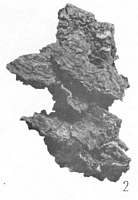|
 Stereum aotearoa Stereum aotearoa
BiostatusPresent in region - Indigenous. Non endemic
Images (click to enlarge)
Caption: Pl. 22, fig. 2. Stereum aotearoa, x 1. | 
Caption: Fig. 3. Transverse section of Stereum aotearoa, x 500. Showing gloeocystidia, monomitic
hyphal system cemented towards the base. Spores, x 1000. |
Article: Cunningham, G.H. (1956). Thelephoraceae of New Zealand. Part IX. The genus Stereum. Transactions of the Royal Society of New Zealand 84(2): 201-231.
Description: Hymenophore annual or perennial, coriaceous, pileate, sessile. Pilei effused-reflexed with
broad resupinate bases, to 10 mm radius, 2.5-3.5 cm wide, applanate or umbonate and
imbricate when to 2.5 cm radius, 4-6 cm wide, or resupinate when appearing as several
orbicular discs of varying size (3-10 mm) scattered over the substratum; pileus surface
chestnut-brown, hirsute, concentrically zoned and sulcate, radiately sulcate, when old
becoming denuded partly or wholly and exposing the brown cortex; margin concolorous,
inturned, crenate; hymenial surface grey when fresh, when dry bright chrome-yellow, even, or
more often with raised radiating ridges, irregular spines or projections, finally sparsely
creviced. Context ferruginous, 0.2-0.3 mm thick in the current layer, in stratose forms to 1 cm
thick near the base, composed of compact mainly parallel hyphae with cemented walls, and a
coloured cortex beneath the surface hairs; hyphal system monomitic; generative hyphae 3-4 µ
diameter, walls 0.5 µ thick (to l µ thick in the cortex and surface hairs), pallid chestnut-brown, septate, branched, with prominent clamp connexions. Hymenial layer to 100 µ deep, a
dense cemented palisade of basidia, paraphyses and gloeocystidia. Basidia sub-clavate, 32-56
x 7-9 µ, 2-4-spored; sterigmata arcuate, stout, to 10 µ long. Paraphyses slightly narrower and
about two-thirds the length of the basidia. Gloeocystidia cylindrical or subclavate, arising in
the base of the hymenium and traversing the hymenium, not projecting, scattered or crowded,
60-110 x 6-10 µ, collapsing and leaving lacunae in the hymenial layer of old specimens.
Spores elliptical, oval, or obovate, some apiculate, 8-12 x 6-7.5 µ, walls smooth, hyaline, 0.2
µ thick.
Habitat: HABITAT. Bark or decorticated decaying wood of erect trunks.
Distribution: DISTRIBUTION. New Zealand
Notes: One of the most easily recognized species present in New Zealand, S. aotearoa may be
differentiated by the hirsute and zoned pileus, long gloeocystidia, brown hyphae of the
context, monomitic hyphal system, large broadly elliptical spores and chrome-yellow colour
of the hymenial surface. The species is perennial, as is shown by numerous zones in the
context of old specimens. Though even in young specimens, as plants age the hymenium may
become radiately lamellate, studded with irregular warts, or even shallowly rugulose-porose.
Sections are striking; for the generative hyphae are brown, cortex deep chestnut-brown and
cemented, and the hymenial layer is hyaline. Basidia are large, firmly compacted into a
palisade with associated paraphyses and gloeocystidia, and collapse as soon as spores are
shed. Gloeocystidia are difficult to detect unless sections are taken from margins of growing
tissues; for contents are colourless and the walls soon collapse, leaving cavities in the base of
the hymenial layer.
Nothing resembling the species was seen in Kew herbarium. Filed under S. contrarium Berk.
there is a collection of S. aotearoa ex "Puhi Puhi, N.Z., No. 221, T. Kirk". On the sheet
Bresadola had written "An St. medicum Currey. Sed vix Stereum; ? Irpex. Non S. scytalis
affine". Bresadola (1916, 232) referred both S. contrarium and S. scytale Berk. to S. princeps
(Jungh.) Sacc., a different plant with acanthophyses. Our species does not resemble any of
these. Its specific name is derived from the Maori name of New Zealand.
|